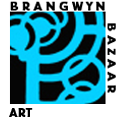
PRINTS
Brangwyn was a fervent believer that art should be accessible to all, regardless of wealth or station, which probably explains his interest in autographic processes. A mass produced printed work was obviously considerably more affordable for the general population than a one-off oil painting. Although Brangwyn cut corners – he would rework an image in a variety of media and frequently recycled areas of etching plates to produce another print run – he appeared to give his printed work as much attention to detail and composition as his original pieces.
His interest in printing processes is reflected in the fact that he was made an Associate and Fellow of the Royal Society of Painter-Printmakers in 1903; was the first President of the Society of Graphic Art in 1921, a group which exhibited both drawings and prints at the Royal Institute galleries from 1921 to 1940; and was an active member of the Senefelder Club founded in 1909, succeeding Joseph Pennell as President.
ETCHING
Between 1900 and 1948 Brangwyn produced over 500 etchings. Brangwyn experimented with printing processes. His plates were often ‘deeply bitten’ and printed with a combination of raw sienna, burnt sienna and French black on buff coloured sheen paper, the precise inking and wiping of the plate playing an important part in the final production, producing dramatic chiaroscuro. Many of the plates were large, some over 70cm (27.6in) square, and for that reason Brangwyn used soft zinc rather than the more expensive, but traditional, copper. The etchings were produced in several states, sometimes the first state having only one impression, other editions were as many as 150. Brangwyn employed the expertise of both Frederick Goulding and Welch to print his etchings.
The etchings depict landscapes, townscapes, Brangwyn’s favourite bridges, windmills and city gates, industrial locations and the outcasts of society – beggars, cripples and blind people – although there are few portraits. What is immediately apparent in the etchings is the incredible draughtsmanship and technical facility especially when dealing with engineering, architectural and marine subjects.
WOODCUTS
Brangwyn produced over 315 wood engravings and woodcuts, many of them intended as book illustrations and head and tail pieces. He cut the woodblocks himself.
LITHOGRAPHS
The Senefelder Club promoted self-printing and Brangwyn was one of a small but dedicated number of artists who prepared his own stones, drew lithographs directly on the stone rather than using transfer paper, and could print his own proofs. Most of Brangwyn’s lithographs, however, were printed by T R Way and the Gouldings in Britain and probably by Clot in France, whilst The Avenue Press printed the majority of his war and commercial posters.
Brangwyn produced over 200 lithographs (excluding his war work and Stations of the Cross). Many of these were for special editions of magazines (Neolith, The Studio); books (Verhaeren’s, Les Campagnes Hallucinees) and art folios (Brangwyn Portfolio). Although the works generally depicted Brangwyn’s muscular men in fields and factories, some early lithographs are unusually soft and gentle in character, with Art Nouveau figures.
COMMERCIAL WORK
Brangwyn had very definite ideas on art in advertising. The artist was one of a rare breed of Academicians who were prepared to work for commercial enterprises, and produced over 40 posters between 1899 and 1936. The posters are quite stylised, emotive, bold in outline and frequently combine image and lettering.
Clients included London & North Eastern Railway, London Underground, Orient-Pacific Line, E Pollard & Co., Royal Institute of British Architects, Stephenson’s Floor Polish, The Studio magazine and Zambrene rubberless coats. Brangwyn’s humanitarian interests were indicated in posters for the Abolition of Capital Punishment, Barts Hospital (donated without charge), French Benevolent Society, and General Relief Fund for Women and Children in Spain.
The selection of prints below is in date order (the number in brackets following the title of each Brangwyn work indicates the number by which the work is identified in the Catalogue Raisonne).
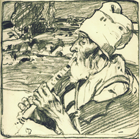 |
 |
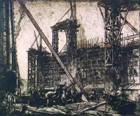 |
| Goatherd (P1526), c1897, lithograph, 18.5x18.5cm, monogram b.l., multiple ownership. Ill: The Studio, October 1897, p9 (original lithograph printed as special supplement. | Grafton Galleries (P2799), 1899, lithograph poster printed by Charles Verneau, Paris, 87x61cm, monogram b.l., multiple ownership. Exh: Brangwyn - Loans Retrospective, Arents House, Bruges, 1987; Brangwyn, Haslam and Whiteway, June 2001, cat 2; Origins of L'Art Nouveau. The Bing Empire , Amsterdam, Munich, Barcelona, Brussels, 2005. Lit & Ill: Wenlock, 'L'Art Nouveau at the Grafton Galleries', The Poster, August 1899, p275; Marechal, Frank Brangwyn: Collection Catalogue, Bruges, 1987, p106; Timmers (Ed), The Power of the Poster, V&A, 1998, p81,82; Eidelberg, S Bing and L C Tiffany, 19th century art worldwide, 2005. Lit: Duffy, 'Frank Brangwyn and the Curious Incident of art in the Tate', British Art Journal, Summer 2007, p50. Ill: Weisberg, Art Nouveau Bing: Paris Style 1900, New York, 1986, p156; McBrinn, 'Frank Brangwyn and stained glass', Journal of Stained Glass, 2004, p31; Duncan, Louis Tiffany. The Garden Museum Collection, Woodbridge, 2004, p550; Weisberg, Becker, Posseme, The Origins of L'Art Nouveau. The Bing Empire , Van Gogh Museum, 2005, p172. The poster was commissioned by Bing to advertise his exhibition of Tiffany and Meunier in London. Two of Brangwyn's stained glass panels, made by Tiffany, were included in the exhibition. | Building the Victoria and Albert Museum (E711), 1904, zinc etching printed by Goulding, 50x60,8cn, multiple ownership. Studies: Building the new Victoria and Albert Museum, watercolour, private collection. Exh: Original Etchings and Drypoints, Rembrandt Gallery, London, 1905, cat 34; Etchings by F Brangwyn, Rembrandt Gallery, London, 1907, cat 17; Etchings by Frank Brangwyn, Rowleys, Manchester, 1912, cat 18; Drawings and Etchings by F Brangwyn, Whitechapel Art Gallery, London, 1925, cat 14; Ferens Art Gallery, Hull, 1931; The Fine Art Society, 1931; Brangwyn, Ferens Art Gallery, Hull, 1933, cat2; Etchings and Lithographs by Frank Brangwyn, Brighton Museum and Art Gallery, 1935, cat 110; Art of Frank Brangwyn, Jointure Studios, Ditchling, 1980, cat 9; Prints and Drawings, Sir Frank Brangwyn, Victoria Art Gallery, Bath, 1983, cat 59; Frank Brangwyn. Exposition de Gravures, Festival de Melle, France, 1988, cat 19; Scarborough Art Gallery Touring Exhibition, 1994, cat 10. Lit and Ill: Gaunt, Etchings of Frank Brangwyn RA, London, 1926, cat52; Marechal, Frank Brangwyn: Collection Catalogue, Bruges, 1987, p202; Architectural Etchings of Frank Brangwyn, Westminster, undated, p5. Lit: Salaman, Modern Masters of Etching: Frank Brangwyn RA, London, 1924, p4,5; Gillow, Catalogue of the Works by Sir Frank Brangwyn RA, William Morris Gallery, 1974, p44. Ill: Newbolt, Etched work of Frank Brangwyn ARA RE, London, 1908, cat 22; Shaw Sparrow, The Spirit of the Age, London, 1905, plate 12; Shaw Sparrow, Frank Brangwyn and his Etchings. An Appreciation, 1912. The etching displays Brangwyn's love of architecture, pattern and form and a japanese influence can be discerned in the strong diagonal of the beam foreground. |
 |
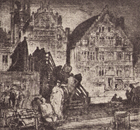 |
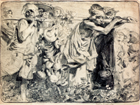 |
| Santa Maria della Salute (Through the Rigging) (E777), zinc etching, 54.5x81cm, multiple ownership. Studies: Santa Maria della Salute, Venice, Arents House, Bruges. Related works: Santa Maria della Salute (O240), Manchester Art Gallery. Exh: Milan International Exhibition, 1906 (Grand Prix); Royal Academy, London, 1906, cat 1324; Venice Biennale, 1907 (gold medal); International Fine Art Exhibition, Rome, 1911, cat 710; Drawings and Etchings by F Brangwyn, Whitechapel Art Gallery, London, 1925, cat 35; Etchings and Lithographs by Frank Brangwyn, Brighton Museum and Art Gallery, 1935, cat 12; Society of Graphic Art 50th Anniversary, Mall Galleries, 1971, cat 172; Art of Frank Brangwyn, Brighton, London, Sheffield, 1980, cat 61; Frank Brangwyn. Exposition de Gravures, Festival de Melle, France, 1988, cat 39; Scarborough Art Gallery Touring Exhibition, 1994, cat 22; Frank Brangwyn 1867-1956, Leeds, Bruges, Swansea, 2006. Lit and Ill: Salaman, Modern Masters of Etching: Frank Brangwyn RA, London, 1924, p6, plate 5; Gaunt, Etchings of Frank Brangwyn RA, London, 1926, cat7; Marechal, Frank Brangwyn: Collection Catalogue, Bruges, 1987, p210. Lit: Shaw Sparrow, Prints and Drawings by Frank Brangwyn, London, 1919, p119; Gillow, Catalogue of the Works by Sir Frank Brangwyn RA, William Morris Gallery, 1974, p63; Alford and Horner (Eds), Brangwyn in his Studio. The Diary of his Assistant Frank Alford, Guildford, 2004, p42. Ill: Newbolt, Etched work of Frank Brangwyn ARA RE, London, 1908, cat 44; Shaw Sparrow, Frank Brangwyn and his Work, London, 1915, facing p204; Lazareva, Frenk Brengvin, Izobrazit, 1978, plate 55; Scarborough Art Gallery Touring Exhibition, 1994, cat 22; Pica, 'Attraverso gli Albi e le Cartelle', Instituto Italiano D'Arti Grafiche Bergamo, undated, p16-17. Based on a drawing taken from the Guidecca, this is probably the best known of Branwyn's etchings, the church of the title is hidden like a talisman in the background, Brangwyn concentrating on the boats, rigging, dolphins and labourers. One copy was printed on sycamore by Goulding (private collection). | Old Houses, Ghent (E723), 1906, copper etching, 55.5x60.8cm, multiple ownership. Studies: Study, Albertina, Vienna. Related works: The plate was cut to make Temporary Wooden Bridge at Ghent (E723). Unloading Bricks, Ghent (E798) deals with the same subject matter - the building of the Sint-Michiels bridge. Exh: Etchings by F Brangwyn, Rembrandt Gallery, London, 1907; Etchings by Frank Brangwyn, Rowleys, Manchester, 1912, cat 37; Exhibition of Original Etchings by Frank Brangwyn, Albert Roullier, Chicago, 1916, cat 9; Etchings and Lithographs by Frank Brangwyn, Brighton Museum and Art Gallery, 1935, cat47; A de Belleroche oils and lithos, Brangwyn etchings, Campbell and Franks, London, 1981, cat 41; Frank Brangwyn. Exposition de Gravures, Festival de Melle, France, 1988, cat 23; Scarborough Art Gallery Touring Exhibition, 1994, cat 14. Lit and Ill: Architectural Review, February 1914, p27; Gaunt, Etchings of Frank Brangwyn RA, London, 1926, cat 64; Marechal, Frank Brangwyn: Collection Catalogue, Bruges, 1987, p204; Architectural Etchings of Frank Brangwyn, Westminster, undated, p5. Lit: Shaw Sparrow, Prints and Drawings by Frank Brangwyn, London, 1919, p143, 144; Norman, The Welsh Connection', The Times, 2 May 1981, p11. Ill: Newbolt, Etched work of Frank Brangwyn ARA RE, London, 1908, cat 36; Levetus, Frank Brangwyn Der Radierer, Vienna, 1924; Pica, 'Attraverso gli Albi e le Cartelle', Instituto Italiano D'Arti Grafiche Bergamo, undated, p173. Five impressions were made of the 1st state, and 150 of the 2nd published state. The etching shows the Corn Exchange and former guildhouse 'De Windas'. Verhaeren described the buildings 'whose pierced fronts seem like cakes of gilded honey'. | Fruit Bearers (P3105), c1906, lithograph, 40x55.5cm, multiple ownership. Exh: Lithographs by Brangwyn and some German artists, Berlin Photographic Co, London, 1913, cat 1a. Ill: Weixlgartner, 'Frank Brangwyn als Graphiker', Die Graphischen Kunst Vienna, 1909; Prints, Bonhams catalogue, 27 June 2005, Lot 119; Pica, 'Attraverso gli Albi e le Cartelle', Instituto Italiano D'Arti Grafiche Bergamo, undated, p179. There may have been 2 states, one of which was coloured. Judging by the style the date may in fact be nearer 1900. |
 |
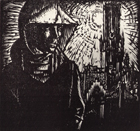 |
 |
| Way of Business (P1084), 1913, 3 colour lithographic poster printed by the Westminster Press on behalf of the Senefelder Club, 101.6x63.5cm, multiple ownership. Related works: Painting their Sweetheart (O2410), pwu, appears to use the same figurehead. Lit and Ill: Marechal, Frank Brangwyn: Collection Catalogue, Bruges, 1987, p285. Ill: Yockney, 'Some Recent London Posters', The Studio, January 1915, p289; Green, Underground Art, London, 1999, p22; Bowness and Green (Eds), London Transport Posters. A Century of Art and Design, London, 2008, p88. Designed by Brangwyn for London Underground stations of Wapping and Rotherhithe. | Sister Ursula, Bruges (V1475), 1919, 10.3x10.7cm, woodcut on paper, multiple ownership. Studies: Original woodblock, Liss Fine Art. Lit and Ill: Marechal, Frank Brangwyn: Collection Catalogue, Bruges, 1987, p131. Ill: Binyon, Bruges, London, 1919, foreword page; Shaw Sparrow, Prints and Drawings by Frank Brangwyn, London, 1919, p77, 151; Modern Woodcutters No 2, London, 1920; Shaw Sparrow, Advertising and British Art, London, 1924, p163. The image may be of a nun who tended to Lucy Brangwyn when she fell and broke her ankle in 1908. The building in the background would appear to be the belfry of the town hall, next to the Basilica of the Holy Blood where Brangwyn's father helped with designs for the monstrance throne and painting the choir-stall walls. | Snowy Tree (V3571), c1920, 3 colour woodcut on paper, 14x20.6cm, multiple ownership. Lit and Ill: Marechal, Frank Brangwyn: Collection Catalogue, Bruges, 1987, p255. Ill: Horner, 'Brangwyn and the Japanese Connection', The Decorative Arts Society, Journal 26, 2002, p75. This coloured woodcut shows a Japanese influence on Brangwyn's work. |
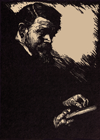 |
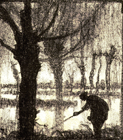 |
 |
| Self Potrait (V1725), c1923, woodcut on paper, 18x12.9cm, multiple ownership. Lit and Ill: Marechal, Frank Brangwyn: Collection Catalogue, Bruges, 1987, p256. Ill: Etchings and Lithographs by Frank Brangwyn, Brighton Museum and Art Gallery, 1935, facing title page. A dark and dramatic woodcut - like Rodin's balzac there is no apparent body and yet one feels the prescence of the man. | Trees in Water (P4611), c1927, lithograph, 18.5x16.7cm, multiple ownership. Ill: Verhaeren, Les Campagnes Hallucinees, 1927, p33 | Pollard Poster - Sawyers (P2824), c1930, 3 colour photo-lithograph poster, 71x46cm, monogram b.l., multiple ownership. Studies: Sawyers, Arents House, Bruges. Photographs CPP 1,2, 3, 48, 14, private collection. Related works: Pollard Exhibition of Furniture Catalogue, 1930 and the Rowley Gallery Fašade, 140-142 Kensington Church Street, London (A1854) have similar figures. Exh: Brangwyn Centenary, Cardiff, Aberystwyth, Haverfordwest, Swansea, Bangor, 1967, cat 121; Brangwyn's Gift, Brighton Museum and Art Gallery, 2007. Lit and Ill: Marechal, Frank Brangwyn: Collection Catalogue, Bruges, 1987, p287. The poster and it's companion, Planers (P2825) were produced for the firm E Pollard with whom Brangwyn collaborated in 1930 to produce four furniture showrooms. |
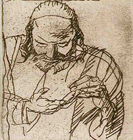 |
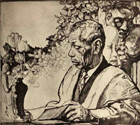 |
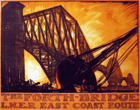 |
| Man with Knife (E4158), 1931, etching, 8x6.2cm, multiple ownership. Ill: Jerome and Jean Tharaud, L'Ombre de la Croix, Paris, 1931, Book 1, p143. L'Ombre de la Croix describes the lives of the Jewish community in Belz, Poland. This image shows a man testing the sharpness of a blade on his fingers prior to slitting the throat of a chicken in kosher fashion. Despite being renowned for working on a grand scale the small etchings Brangwyn produced for this publication proved that he could also work on a small scale. | Portrait of Yamanaka (E1015), c1931, dry-point etching, 57.2x65.2cm, monogram on plate centre, multiple ownership. Exh: Etchings and Lithographs by Frank Brangwyn, Brighton Museum and Art Gallery, 1935, cat 65; Etchings and Lithographs, Frank Brangwyn, Walthamstow Museum, 1937; Prints and Drawings, Sir Frank Brangwyn, Victoria Art Gallery, Bath, 1983, cat 36; Scarborough Art Gallery Touring Exhibition, 1994, cat 65; Brangwyn, William Morris Gallery, 2007. Lit and Ill: Salaman, Modern Masters of Etching No 30, London, 1932, cat 12; Marechal, Frank Brangwyn: Collection Catalogue, Bruges, 1987, p247. Lit: 'Second Exhibition of Etchings and Lithographs presented by Frank Brangwyn RA at the Walthamstow Museum', Apollo, April 1937, p223; Gillow, Catalogue of the Works by Sir Frank Brangwyn RA, William Morris Gallery, 1974, p59. Ill: 'Book Reviews', The Studio, Vol 103, 1932, p244; Scarborough Art Gallery Touring Exhibition, 1994, cat 65. Only 9 impressions were made of this etching of Sadajiro Yamanaka, a well known connoisseur and dealer in japanese and Chinese art, who owned a gallery at 127 New Bond Street from 1900 until the start of WW2. The Apollo critic described the work as 'a life-size portrait etching which has no parallel, I believe, in British art'. | Forth Bridge (P4141), 1923-1947, poster printed by the Avenue Press, London, 102x127cm, monogram on plate b.r., multiple ownership. Studies: Photographs EP283 and 155, Liss Fine Art. Exhibited: Travel in Style, Snibston Discovery Park, 2004. The poster was one of a number Brangwyn designed for the London and North Eastern Railway and shows a Japanese influence in the way the bridge is silhouetted boldly against the sunburst sky and also in the fact that Brangwyn produced the lettering. He was one of the first Royal Academicians to design posters for a rail company. |